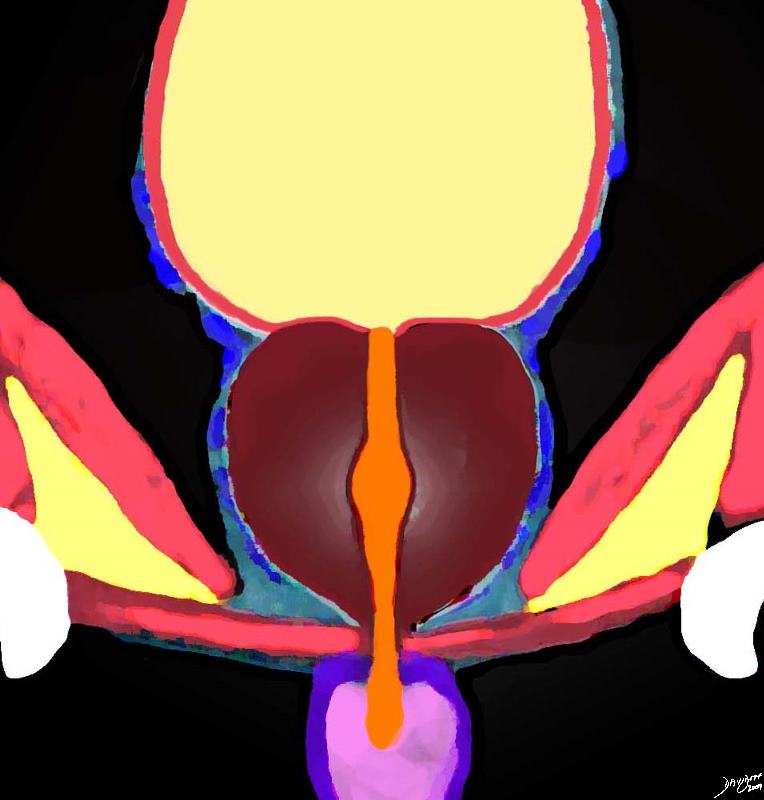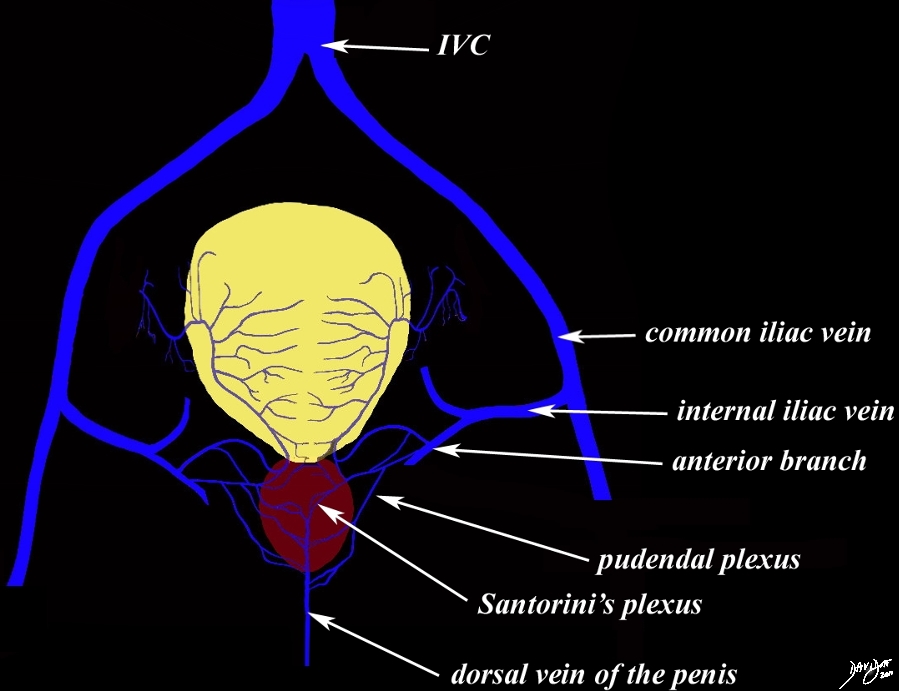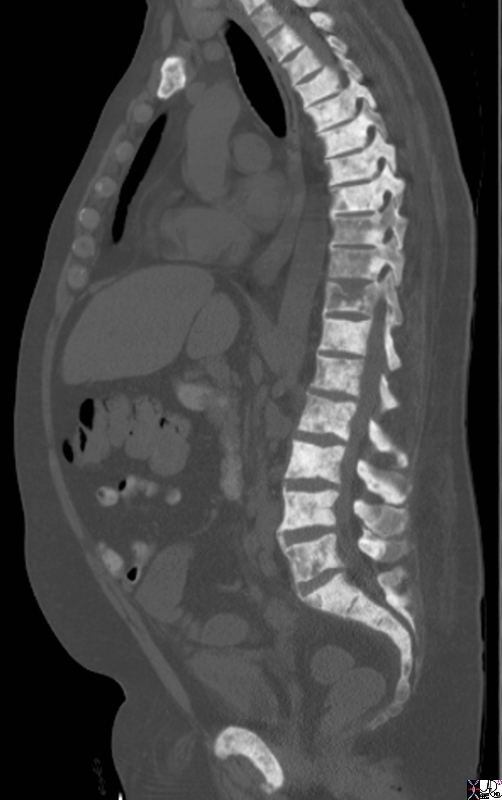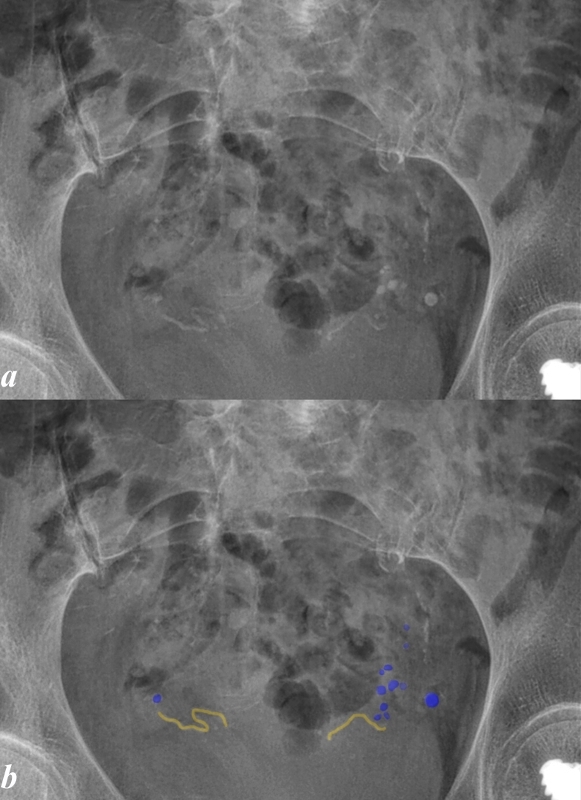The Common Vein Copyright 2011
Introduction
Structurally, the venous drainage of the prostate is through the prostatic plexus. The plexus surrounds the prostate like a net and joins the venous drainage of the penis (deep dorsal vein) in Santorini’s plexus.
The periprostatic plexus consists of the anterior plexus called Santorini’s plexus that lies behind the pubic symphisis in the retropubic space of Retzius and the paraprostatic plexus called the pudendal plexus (vesicoprostatic plexus) which drains both the inferior aspect of the bladder as well as the prostate.
|
The Paraprostatic Venous Plexus (blue) |
|
The diagram reflects shows the prostate and bladder with the lateral venous plexuses outlined in blue. They combine with the venous plexus that lies anteriorly in the space of Retzius as well as Batson’s plexus to finally drain into the iliac and azygos systems. Image Courtesy Ashley Davidoff Copyright 2010 99651b07.8s |
The usual drainage of the prostate is via the internal pudendal vein which drains into the anterior branch of the internal iliac vein. The plexus however does collateralize with the external pudendal vein which drains into the external iliac system, and the vertebral venous system or Batson’s plexus, which is the valveless system that drains the spinal cord and vertebral column. The intervertebral veins and the epidural venous plexus, collateralize at all levels of the spinal canal and vertebral bodies and also drains into the azygos system. Thus venous drainage goes three ways; internal iliac, external iliac, and azygos via the collateral systems of Santorini’s plexus, vesicoprostatic plexus and Batson’s plexus
|
Venous Drainage of the Prostate |
|
The diagram reflects the venous drainage of the prostate which is in common with the venous drainage of the penis and bladder. The dorsal vein of the penis divides into two forms a plexus anterior to the bladder called the preprostatic plexus of Santorini. This plexus collateralizes with the pudendal (paraprostatic ) plexus that lies on the lateral aspects of the prostate . The veins finally drain into the anterior branches of the internal iliac venous system via the internal pudendal vein. Courtesy Ashley Davidoff Copyright 2010 96269b35b01d02Vp03L.9s |
Applied Anatomy
Diseases, such as infection and cancer may spread through the venous drainage to the distant organs.
Radiation seeds, used in the treatment of prostate cancer, may also embolize through the venous drainage system either via the iliac or via the azygos system.
The most usual method is via the internal iliac system and into the IVC and then pulmonary circulation.
|
Embolized Radiation Seeds in the Lower Lobes |
|
56 year old male with prostate carcinoma has radiation seeds implanted into the prostate gland. A chest X-ray following the procedure shows at least 4 of the seeds in the base of the right lung and 2 of the seeds in the mid left lung field. An azygos lobe is of incidental note. In the image below the small embolized seeds are overlaid to allow recognition Courtesy Ashley Davidoff MD copyright 2009 all rights reserved 29676b.8s |
|
Radiation Seeds Embolized to the Lung Bases |
|
56 year old male with prostate carcinoma has radiation seeds implanted into the prostate gland as seen by the radioopaque pellets in the prostate gland in image a. A chest X-ray following the procedure shows at least 4 of the seeds in the base of the right lung and 2 of the seeds in the mid left lung field overlaid in green (c). Image d is a magnification of the right lower lobe and the seeds are overlaid in green in image e. Courtesy Ashley Davidoff MD copyright 2009 all rights reserved 29676c05.8s |
It is not unusual for metastatic prostate cancer to affect the vertebral column and it does this by it connection with Batson’s plexus which is the valveless system that drains the vertebral bodies and the cord.
|
Blastic Disease in the Spine from Prostate Carcinoma |
|
The sagittal reconstruction of the thoracic and lumbar spine is from a 50 year old male with known prostate carcinoma shows extensive blastic metastases involving almost all the visualized bones including the entire spine, pubic symphisis and probably sternum. The findings are consistent with extensive blastic metastasis from primary prostate carcinoma. The spread of carcinoma from the prostate to the spine is enabled by the valveless venous system of Batson that is within and surrounds the vertebral column and shares venous drainage with the prostate. Image Courtesy Ashley Davidoff MD Copyright 2010 98793.8s |
The venous plexus is of particular importance in treatment during radical prostatectomy, when division of the dorsal venous complex can result in significantly increased risk of blood loss.
Phleboliths or calcifications within the prostatic veins are common in older patients and may be seen on CT. They have no clinical significance other than causing some difficulties in differentiating ureteric stones from phleboliths.
|
Phleboliths of the Paraprostatic Plexus |
|
Plain film of the pelvis shows phleboliths in the veins of the periprostatic plexus (blue). The vas deferentia are overlaid in orange. These become calcified in patients with diabetes, sometimes sarcoidosis and in elderly patients. Image Courtesy Ashley Davidoff Copyright 2010 83603cp.8s |






